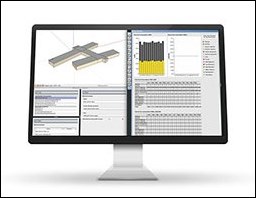by Brianna Crandall — November 27, 2013—An energy audit tool that more accurately pinpoints potential energy savings while potentially costing 35% to 75% less than traditional audits is set to hit the multibillion-dollar energy retrofit industry next year. The simuwatt Energy Auditor software package was developed by the U.S. Department of Energy’s (DOE) National Renewable Energy Laboratory (NREL) in partnership with Denver-based software developer concept3D.
simuwatt Energy Auditor’s software-guided workflow replaces the clipboard-and-pencil approach of most building audits with a package that uses sophisticated, comprehensive computer modeling to find more potential energy savings in energy-demanding commercial buildings, thereby saving net operating income, reducing greenhouse gases, and increasing the occupant comfort level.
Energy service companies, or ESCOs, are often the ones performing energy audits these days, absorbing the audit costs and making improvements at low cost, in exchange for a share of the money saved on monthly utility bills, explains NREL. This model works well for large buildings, but traditional audits can be cost prohibitive for small buildings. simuwatt Energy Auditor will allow ESCO employees to perform audits simply using mobile tablets and advanced energy modeling, thereby lowering costs, with the goal of deeper savings for more buildings.
When the audit is finished, it is stored electronically and serves as the baseline for the next audit, which is typically done a few years later. “The subsequent audit becomes verification, not a new discovery,” said NREL Senior Engineer Larry Brackney. “So, the cost of subsequent audits comes down sharply.”
Combination of tools
NREL combined a variety of tools and ideas to create simuwatt Energy Auditor, marrying the energy audit with energy modeling through OpenStudio and other tools. concept3D, which pulled together the idea of capturing the geometry of a building by taking photos of the exterior, then layering those on top of a three-dimensional rendering of the building, has an exclusive license from NREL to develop the software tool for the marketplace.
simuwatt Energy Auditor benefits from existing tools, including the Energy Department’s EnergyPlus, which runs simulations to determine energy flow; and NREL’s OpenStudio, which allows users to quickly create a detailed EnergyPlus model of the building. concept3D also helped NREL develop its Building Component Library (BCL), an online archive of building energy modeling input data and conservation measures that can be used to create building energy models and figure out how much a particular type of building could save from installing or changing any building component.
simuwatt Energy Auditor lets users drag BCL components into an OpenStudio project. “They then can see the energy and cost impacts,” Brackney said. Users can simulate the effects of adding overhangs to windows, changing rooftop units, changing lights, changing hours of operation — almost any building component that could improve efficiency, added Brackney.
simuwatt Energy Auditor can also measure the benefits of installing solar photovoltaic panels, which NREL says would not be possible without OpenStudio and the BCL. The melding of all these different capabilities was further enhanced by the growing popularity of electronic tablets.
Practical applications for building owners/managers
As an example, NREL says a user could pose the question: “Does it make economic sense to retrofit windows in this building?” The response from simuwatt Energy Auditor might be something like: “Yes, if it is more than three stories high and at least 40 years old and if you use these kinds of windows.” If that is not in the budget, then the user can change one parameter and see what difference it makes for the bottom line.

According to NREL, no other commercially available product has the ability to collect building data onsite, automatically move the data into an analysis tool, and perform a detailed energy simulation with the speed and consistency of simuwatt Energy Auditor. In addition, the same person doing the audit can, say, assess the strength of the roof for the loading of solar panels, partly because of the benefits of cloud computing for running energy models from any device.
simuwatt Energy Auditor moves beyond the “low-hanging fruit” energy improvements that many facilities have already incorporated, says NREL. The tool’s built-in reporting mechanisms and assumptions reportedly provide more useful information than a traditional audit does to decision makers. For example, if an audit reports that lowering lighting density will save so many dollars, a building owner needs to know what assumptions were made, how the costs break down, and how this will impact the operations of the building. The new tool assembles the necessary details.
NREL, concept3D, and industry partners will test the potential savings from the tool by auditing 18 buildings at six Department of Defense bases. More information about NREL’s Commercial Buildings Research is available online.




